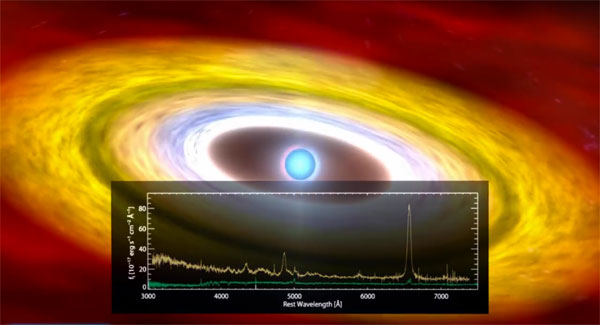When black hole-fueled beacons go dark, astronomers want to find out why.
Astronomers tracking a distant quasar over a span of 13 years reported at the American Astronomical Society meeting in Kissimmee, Florida, that all signs of the quasar have disappeared.

Dana Berry / SkyWorks Digital, Inc. / SDSS collaboration
The quasar, known as SDSS J1011+5442, was first detected in 2002 by the Sloan Digital Sky Survey (SDSS). A follow-up spectrum collected the next year showed all the signs of a typical, ferociously gobbling supermassive black hole sitting at the center of a galaxy. As gas flowed in to feed the behemoth, the material heated up, glowing blue.
Over the next decade, a multitude of surveys monitored the quasar’s behavior: SDSS, the Wide-field Infrared Survey Explorer (WISE) spacecraft, MIT Lincoln Laboratory’s Lincoln Near-Earth Asteroid Research (LINEAR) project, and the Catalina Sky Survey continued to check in on J1011+5442. Over the years, the quasar’s brightness declined steadily. Although quasars often brighten and fade a tenth of a magnitude over the course of a year, this deterioration was more systematic.
When Jessie Runnoe (Penn State) and colleagues observed the quasar again as part of the Time Domain Spectroscopic Survey (TDSS) in 2015, they once more used SDSS to take a spectrum of the beast’s disk of gas. They found nothing — almost all signs of the quasar had vanished. Instead, they saw only a relatively ordinary galaxy. The team has published the results in the Monthly Notices of the Royal Astronomical Society.
One of Many
But this isn’t the first case, nor will it be the last. Sky & Telescope reported a similar shutdown more than a year ago, when the brilliant quasar known as SDSS J0159+0033 dropped out of sight in a similar span of time. And even before that, less luminous examples abounded: Mrk 590, Mrk 1018, NGC 7603, and several more.
These “changing look” active galaxies (as they’re collectively known) seem to come in two varieties. In one, a passing cloud of dust blocks our view of the gobbling black hole for a little while. This cloud scenario more often explains a drop in X-ray brightness, since the X-ray-emitting region around the black hole is small and easy to block with a single cloud.
But in cases where the quasar’s visible-light glow entirely disappears, as with J1011+5442, the cloud scenario becomes a stretch — literally. A quasar’s visible light comes from the accretion disk’s outer regions, and a cloud would have to be ginormous to cover the entire disk and block all its light. Instead, a diet is the more likely scenario. To explain J1011+5442’s disappearance, the black hole would have to have cut its feeding rate by a factor of 10.
Not Clearing Its Plate?
What’s difficult to explain, though, is how the black hole could have gone from “on” to “off” as fast as it did. “The outermost part of the disk, which is responsible for the optical light, would take 800 years to empty out,” Runnoe says. Yet instead of this gradual decline, the quasar’s optical light turned off in just a couple of years, suggesting it ate through the gas at an impossible rate.
To explain the difference, she suggests that the quasar didn’t clear its plate completely in that time. Instead, it just swallowed down the nearest, hottest gas from the inner accretion disk. That could happen quickly, as fast as in a month or two. The hot, inner gas would emit ultraviolet light as it swirls toward the black hole, irradiating the outer disk to make it glow. So when the ultraviolet beacon near the black hole goes dark, the outer disk loses its visible-light shine as well.
The team will continue to monitor J1011+5442’s host galaxy, as there’s a “distinct possibility” that this quasar may yet turn back on, says coauthor John Ruan (University of Washington). In addition, TDSS has already discovered dozens more of these quasars gone quiet. With additional searches for transients on the horizon, such as the just-starting TDSS and the Large Synoptic Survey Telescope (LSST) scheduled to come online in 2019, there will doubtless be more to come.
 4
4









Comments
Peter Wilson
January 28, 2016 at 12:26 am
Black Hole Goes Dark
You must be logged in to post a comment.
P.Michael-Hutchins
January 30, 2016 at 11:20 am
It's understandable that your article's inline graphcs are too small to see the details in -- but it's not understandable that they don't expand to a usable size.
You must be logged in to post a comment.
Monica YoungPost Author
February 1, 2016 at 12:10 pm
Unfortunately, I had to grab this particular graphic from the YouTube video, which is limited in resolution . . . I wanted to show the difference between the two spectra and no such graphic was available outside the video.
You must be logged in to post a comment.
bwana
January 31, 2016 at 12:29 am
Maybe the entity running the simulation just simply turned off the quasar!? 🙂
You must be logged in to post a comment.
You must be logged in to post a comment.